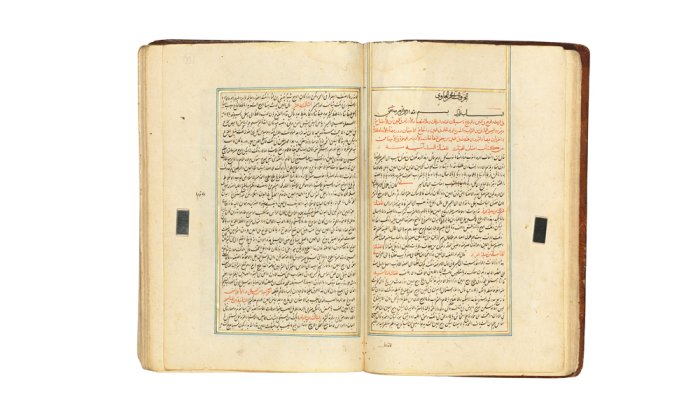Sex and 'Female Semen' in the Medieval Arab World

For millennia, it’s understood that all humans produce semen, whatever their sex. Medieval Arabic literature and medical texts are filled with accounts of a generative female seed and women gushing fluids in moments of passion. Islamic scholars embrace theories of conception proposed by Hippocrates, Aristotle, and Galen. The notion that both men and women play a part in procreation aligns with Islam. Surah 49 of the Holy Quran reads, “O humanity! Indeed, We created you from a male and a female.” Surah 76 states that man was created from a “drop of mingled sperm,” and the hadiths explain that women also contribute semen to conception. How else to explain the fact — and we’ve heard this argument before — that daughters and sons resemble their mother?

Eminent medieval physicians like Avicenna (that is, Abū Alī al-Husain ibn Abd Allāh ibn Sīnā) or Ibn al-Qayyim al-Jawziyya subscribe to the Hippocratic or Galenic two-seed theory. Avicenna (ca. 980–1037), the Persian doctor and philosopher, describes healthy female semen as glistening and whitish, with the scent of palm blossoms and elderberry. There are echoes of Aristotle in Avicenna’s characterization of female seed as thinner, weaker, and more blood-like than male semen. The female fluid readies things for the fetus and then empties into the vagina, where it mixes with male ejaculate before being sucked back into the uterus. Experienced at once, these various sensations — the flow of seed, burst of male fluid, and uterine sucking action— are enough to trigger climax in women.
Avicenna is confronted with an obvious conundrum: Why do some women conceive without having orgasmed? How can pregnancy occur without female seed? The doctor riddles it out: whenever a woman becomes pregnant without having ejaculated, it’s because fresh male seed has fertilized older female semen still found in the uterus. If a man is fundamentally unable to please his wife in bed, the union will remain childless; a small penis is often to blame for infertility, Avicenna explains, because a woman is less likely to experience pleasure in intercourse, such that she does not ejaculate, and if she does not ejaculate, he concludes, there can be no child. There are serious consequences when a woman doesn’t ejaculate. Issues can also arise if she ejaculates, but her semen goes unfertilized and forms abnormal masses in the uterus. These tumors result from masturbation or nocturnal emissions; it is a truth acknowledged by old Arabic physicians and scholars, too, that women experience wet dreams.
It is a truth acknowledged by old Arabic physicians and scholars that women experience wet dreams.
Ibn al-Qayyim al-Jawziyya (1292–1351), born in Damascus, believes that male and female seminal fluids are matched in generative power, but differ in other respects. Female semen is yellowish and thin. Rather than spurting, it flows from the body — if at all. There is the notion that, although required for conception, female semen stays in the body. In “The Treatise on Anatomy of Human Body and Interpretation of Philosophers” (1632), Šams ad-dīn al-Itāqī vividly depicts the movement of female semen within the body. The fluid is “yellow like cold mild [sic]” and contained in the uterus, where it mixes with male semen—“white and heavy like the rennet” — during coitus: “The male semen has the power of formation and the female semen provides substance. When they are united, harmony appears.”
Islamic jurisprudence is influenced by the belief that male and female semen contribute to conception. Legal scholar and theologian Abū Hāmid Muhammad ibn Muhammad al-Ghazālī (1058–1111) argues that coitus interruptus (or azl) is necessarily permissible (mubah) and contraception does not contravene religious precepts. In one of the “most remarkable documents in the history of birth control,” al-Ghazālī reasons that a fetus doesn’t form until male and female seeds have mixed in the uterus. Whereas aborting a fetus constitutes a crime against a living being, preventing pregnancy or withdrawing the penis before ejaculation does not. On its own, male semen is nugatory. Any form of contraception that prevents fluids from interacting, whether barrier methods or coitus interruptus, is therefore allowed. Several scholars even sanction (male) masturbation since male semen isn’t particularly valuable.
Old Arabic texts do not, however, explain how a woman might curb her seminal emissions to avoid pregnancy. Is there an equivalent to coitus interruptus or coitus reservatus in women? “Kitāb al-Ḥāwī” is a monumental medical and pharmaceutical encyclopedia composed in the 10th century by Persian polymath and physician Abu Bakr Muhammad Ibn Zakariya al-Rāzī. The 25-volume work, a detailed survey of knowledge from classical antiquity to the Middle Ages, is one of the most important primary sources on contemporary sexual health practices. “Al–Ḥāwī” alone contains 176 remedies related to conception and abortion, including orally ingested physics, magical tonics, barrier methods (e.g., tampons prepared with honey, pepper, peppermint oil, or dill), such male practices as rubbing the penis in pine tar or balsam oil prior to intercourse, and techniques used primarily by women. Only once, though, does “Al-Ḥāwī” state that pregnancy can be prevented by a man’s climaxing first, thus denying his lover her own orgasmic expulsion. Medical figures like Avicenna and Abu al-Hasan al-Tabari adopt al-Rāzī’s idea before this method of contraception vanishes from the literature.
Amīn-ad-Daula Abu-‘l-Faraǧ ibn Yaʻqūb ibn Isḥāq Ibn al-Quff al-Karaki (1233–1286) authors one of the few Arabic monographs on surgery. In “Basics in the Art of Surgery,” Ibn al-Quff presents his ideas on female semen and uterine anatomy. Following Galen, he interprets female genitalia as male genitalia. Women are colder than men, he states, which is why their reproductive organs are located inside the body, and their seed is thinner and less abundant. Female semen, Ibn al-Quff continues, streams into the uterus from the testicles: “Each ‘testicle’ (baiḍatān) is connected to the uterus by a channel (mağran), along which the [female] semen flows. This is known as the seminal sling (qāḏif al-minā).”
A more literary take on female seed can be found in “The Perfumed Garden,” a 15th-century sex manual by Abū ʿAbdallāh Muḥammad an-Nafzāwī. Like their Indian predecessors, this and other textbooks explain the ins and outs of lovemaking and personal hygiene, but include erotic poems and tales as well. The opening lines of “The Perfumed Garden” celebrate the Creator and physical desire in both men and women:
Praise be given to God, who has placed man’s greatest pleasure in the natural parts of woman, and has destined the natural parts of man to afford the greatest enjoyment to woman.
He has not endowed the parts of woman with any pleasurable or satisfactory feeling until the same have been penetrated by the instrument of the male; and likewise the sexual organs of man know neither rest nor quietness until they have entered those of the female.
The book outlines sexual techniques and problems, discloses sources of pleasure and displeasure, provides treatments for female infertility, and explains how to end a pregnancy. A “meritorious man” will be endowed with a “strong, vigorous and hard” member, “not quick to discharge.” Premature ejaculation and quickies are considered unfeeling. Foreplay is key (“toy with her previous to the coition; prepare her for the enjoyment, and neglect nothing to attain that end”), essential to making both lovers’ fluids “flow over at the same time.”
Old Arabic texts introduce medieval Europe to the significance of foreplay, kissing, and pillow talk.
Old Arabic texts introduce medieval Europe to the significance of foreplay, kissing, and pillow talk. According to Muslim sexology of the time, female desire and orgasm are essential, and ought not to hinge on male orgasm. The idea that a man should tend to female desire, to allow for a woman to reach climax, was missing in Greek and Roman cultures, writes modern-day Islamic theologian Ali Ghandour. In his 2019 study of “Muslims’ suppressed erotic heritage,” Ghandour quotes a 10th-century text: “Know that the man most loved among women is he who knows how to behave toward them and fulfill their [wishes].” The most important trait a man can have is the ability to recognize female desire and know how to satisfy it.
“The Perfumed Garden” states that when a man dreams of a woman’s vulva — feurdj, or “slit” — it means “if he is in trouble God will free him of it; if he is in a perplexity he will soon get out of it,” grow wealthy, and settle his debts. Even “more lucky” is to dream of an open vulva. “The Perfumed Garden” describes female genitalia in rich, if ambiguous and uneven, terms: “El maoui (the juicy).—The vagina thus named has one of the four most abominable defects which can affect a vagina; nay, the most repulsive of all, for the too great abundance of secretions detracts from the pleasures of coition. This imperfection grows still worse when the man by preliminary caresses provokes the issue of the moisture. God preserve us from them! Amen.” The “biter,” meanwhile, is a vulva that “opens and shuts again” on the penis shortly before orgasm. The “large one” is a “vulva which is as wide as it is long . . . , fully developed all round, from side to side, and from the pubis to the perineum. It is the most beautiful to look upon.” Here too, seminal emissions are part of female orgasm: “Then do all you can to provoke a simultaneous discharge of the two spermal fluids; herein lies the secret of love.” In one story, a “profound connoisseur in love affairs” explains that “in acting thus, the two ejaculations take place simultaneously, and the enjoyment comes to the man and woman at the same moment. Then the man feels the womb grasping his member, which gives to each of them the most exquisite pleasure.”
Stephanie Haerdle is the author of “Keine Angst haben, das ist unser Beruf!
Kunstreiterinnen, Dompteusen und andere Zirkusartistinnen” (Not Being Afraid Is Our Job! Circus Riders, Animal Tamers and Other Female Circus Performers) and “Juice: A History of Female Ejaculation,” from which this article is excerpted.
